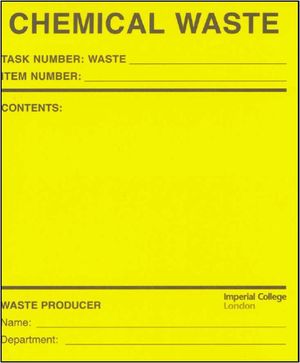CRTS:Chemical Waste
This page contains more detailed information about Chemical Waste Procedures as handled by the Chemistry Research Technicians in the Chemistry Department.
Return to the Waste Management Portal.
Chemical Waste
We are a Chemistry Department and consequently we use many chemicals. It is understandable that we generate a fair amount of Chemical Waste. This is often a more hazardous area than pure commercial chemicals as we do not always know precisely what chemicals we are dealing with.
You can help us, and yourselves, by making sure all chemicals are labelled. Do not store chemicals/waste for longer than necessary. If you are unsure enough about the quality/identity of any research chemicals not to use them for your research - it is unlikely any-one else will want to use them either. Get rid of them as soon as you can. This helps us by reducing the number of unknowns we receive and it reduces the risk to yourselves by storing less of hazardous chemicals.
You may also be wondering where it all goes, for a bit more insight the process is detailed here.
General Waste Streams
There are 4 general waste streams which are collected by the CRT as a weekly routine. Hydrocarbon Solvent Waste, Chlorinated Solvent Waste, Silica and Clinical Waste.
All save clinical waste need to be labelled appropriately before collection with suitable labels, name of producer (PI), location of producer (lab number) and date.
If your lab is not part of a routine collection, please email the Chemistry Research Technicians for collection.
Hydrocarbon Solvent Waste
Hydrocarbon Solvent Waste is produced in most of our labs and filled into 25 L metal drums. Hydrocarbon Waste MUST be labelled with the red tape denoting Hydrocarbon Waste. You can get this from the CRT in 132a.
The metal drums do not tolerate acids as these eat through the metal fabric of the drum and have caused serious leaks and spills in the past. Please be extremely careful not to wash any acids into these drums.
Please also observe general good practice by not over-filling drums, sealing them before collection and keeping the exterior clean and free of oily or greasy materials.
Chlorinated Solvent Waste
Chlorinated Solvent Waste is produced in most of our labs and filled into 20 L plastic drums. Chlorinated Waste MUST be labelled with the yellow tape denoting Chlorinated Waste. You can get this from the CRT in 132a.
Please observe general good practice by not over-filling drums, sealing them with the correct size cap (it will leak if not) and keeping the exterior clean.
Silica
The Silica Waste stream can handle the small amounts of contaminants normally present in waste silica as it goes straight to incineration. Other drying agents (Magnesium Sulphate etc.) are compatible with this waste stream, but you must not mix in alumina, aluminium backed tlc plates or heavy metals.
Silica Waste should be clearly labelled "Silica Waste", with the standard additional information.
Clinical Waste
Clinical Waste has 3 accepted packing materials, all clinical waste gets incinerated so again, it is not compatible with heavy metals.
Sharps (needles and syringes) must be disposed of in solid plastic containers, the accepted types are stocked in VWR stores. They must have a handle to attach clinical waste tags. These have a max fill level to ensure you can close the lid securely - DO NOT OVERFILL THESE CONTAINERS. Make sure the lid is closed securely before labelling the container for disposal.
Pipette tips can be disposed of in cardboard clinical waste containers, these are not safe for sharps (needles) as they can pierce the container. These containers need to be checked by a postdoc or other before being sealed and tagged for collection.
Soft materials (gloves, blue roll etc.) can be disposed of in clinical waste bags. Again, these are not suitable for sharps (needles) or other materials that can pierce the bag.
Lab Smalls

'Lab Smalls' encompass all other chemicals disposed by the department that do not enter the bulk waste streams. This covers particularly hazardous (i.e heavy metal) contaminated wastes as well as chemicals beyond their shelf-life but still in their original packaging.
There is a set procedure for disposing of these items within Chemistry, coordinated by Bill Mason. For more generic college-wide instructions please see the safety page here.
As a brief overview:
- Log a request online, here.
- The 4 digit waste number will be emailed to you (takes 12-36 hours). This is not the same as the 6 digit job number which is generated immediately.
- Label all the containers with yellow labels – indicating item number and batch waste number.
- Record an inventory of the labelled containers on the supplied template. You need to fill in all of the darker columns (each must have a unique item number; the size column is for the size of the container and quantity column for an estimate of the contents e.g 500g in a 1kg container. Quantity is not multiplicity.)
- Pack the items in the green plastic crates provided. Items should be in one single layer and not stacked so that all the containers can remain upright. The lid must be free to close.
- Label the transit containers (green crates) indicating which items they contain (i.e 1-20, 21-40, etc).
- Send an electronic (typed) copy of the inventory to Bill Mason and Roger Smith, including cost code – if an estimate is required Roger Smith can provide this.
- Bill will collect the items, usually the same day.
We can provide yellow labels and green boxes for the items to be packed in. Let us know and we can deliver, or they can be collected from 132A (Technician’s Office).
Email Bill Mason for a copy of the inventory template. (We will try and get a link here soon!)
